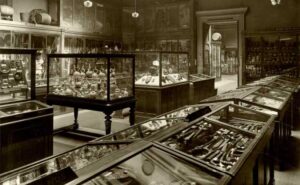
In modern societies, objects are acquired by inheritance or value is accredited to these objects by decontextualising them from the mercantile sphere and depriving them of their interchangeable nature. The abstraction of an object from its dynamic circumstance and placing it within the static sphere of the museum demonstrates a different trajectory followed by a different object. Some of these artefacts highlight the aesthetic and stylistic value, while in other circumstances, they become markers of culture and customs. From a methodological standpoint, these objects have always been in motion, and had a social life. Museums have come to be associated with vision, where the museum effect enhances an object and grabs the attention of the viewer, forming an interactive link between the visitor and the object.
The public museum has traditionally played a significant role in the definition and construction of specific cultural identities by employing a variety of representations. It remains a prestigious public institution, housing cherished artefacts that serve as emblematic evidence. Furthermore, these museums frequently leverage the historical context unique to a region to elucidate its contribution to the broader national identity. Within the context of the public museum, historical narratives assume a significant role in the construction of a national identity. These narratives operate as influential tools in designating a specific historical account as central to the definition, comprehension, and recognition of the nation. The potential inherent in the presentation of public histories in museums extends beyond mere omissions; it resides in the nuanced manner in which history is meticulously curated and showcased.

The concept of the “people” was central to nationalist thought, driving the imagined community. Postcolonialism museums became the platforms for newly emancipated identities, connecting past artists with the contemporary community. Artefacts fostered a collective identity through discussions of history. The interactive engagement with museum artefacts related to these historical narratives can evoke emotive responses and contemplation that resonate with the visitor’s distinctive personal identity. This, in turn, underscores the nuanced and transformative nature of these encounters, as individuals leave the museum with a deeper awareness of their own identities and a heightened sensitivity to the historical forces that have shaped them. Identity involves demographic attributes (e.g., age, gender, socioeconomic status, race, ethnicity), shaping attitudes and behaviour. It also extends to relevant knowledge and experiences tied to specific activities, with varying importance within a changing social context. For example, when a museum exhibits artefacts related to colonisation, it provides a tangible link to the past, enabling visitors to confront the harsh realities of colonial oppression and its enduring impact on marginalised communities. In turn, visitors bring their own perspectives and experiences to these artefacts, resulting in a dynamic interaction. They may reflect on their own cultural identity, their position within a post-colonial society. This two-way interaction between the museum object and the visitor is where the transformative potential lies, as it allows for the construction of meaning and a deeper connection to one’s own identity. The artefacts, documents, and narratives presented in museum exhibits become a conduit for visitors to engage with their own understanding of identity and much more. This process is not unidirectional but rather a dynamic exchange where the visitor’s personal identity is both informed by and contributes to the interpretation and significance of the objects on display. A visit to a museum is a dynamic process that can profoundly shape an individual’s identity and self-concept, particularly when considering historical legacies, such as colonisation and slavery. Museums, in this context, serve as dual agents, playing the roles of preservers of historical narratives and constructors of cultural memory, while engaging in a two-way process of interaction with the visitor.
Objects serve as expressions of personal histories, and storytelling underscores the active construction of narratives, intertwining object and human histories. In India, the dynamic politics of heritage involve conflicting pressures—some aiming to preserve communal identities, others seeking to challenge them. This complexity opens avenues for exploring the biographies of objects and their interactions with human and non-human agents, making museums ideal for such inquiries. Collections and exhibitions cannot be divorced from the larger cultural contexts of ethnic or national identity formation, keeping anthropologists and natives engaged in a dialogue through which cultural identity emerges, where museums play an important role.

